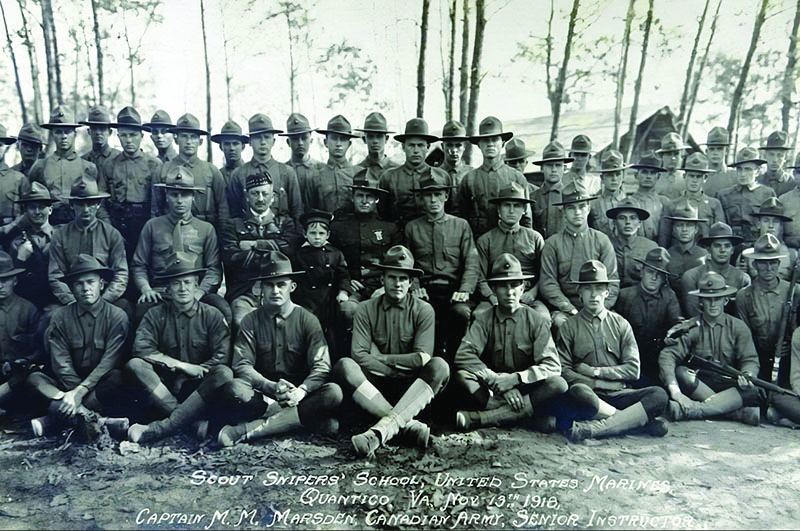
Gone But Not Forgotten: Scout Snipers Memorialize a Century of Service
Posted on May 15, 2025Since 1998, the USMC Scout Sniper Association (SSA) has fervently supported the proud brotherhood of Marine Corps scout snipers.
Tom Ferran, a scout sniper and Vietnam War veteran, founded the organization and began the work connecting the community. Membership grew through the global war on terror, presently peaking around 2,000, including veterans from post-World War II through Marines still on active duty. Today, the organization exists as a 501(c)(3) nonprofit supporting the community, “through programs that inspire brotherhood, encourage professionalism, and foster resiliency,” according to the website.
Now, in partnership with their sister organization, the Marine Scout Sniper Heritage Foundation, this proud community is planning its most ambitious undertaking yet: creating a multi-faceted tribute to the now-defunct military occupational specialty (MOS).
Throughout the existence of the scout sniper MOS, the Corps maintained only 300 to 400 of these long-range gunmen at any given time. Their comparatively small numbers belie the significance these Marines played on the battlefield since their inception during World War I. Origins of the MOS can be traced directly to the spring of 1918 at the Overseas Depot on Marine Barracks Quantico, Va., where 75 noncommissioned officers and 375 privates graduated the Corps’ first official course for scout snipers. The enemy felt their presence on the battlefield in France within months.
Corporal John H. Pruitt earned his spot in history as the first Marine sniper awarded the Medal of Honor, one of only 19 people in history to receive two Medals of Honor. On Oct. 3, 1918, at Blanc Mont, Pruitt attacked two machine-gun nests, capturing both guns and killing two German soldiers. He then located 40 enemy soldiers trapped below ground in a bunker, all of whom surrendered to the 22-year-old Marine armed with a long-scoped Winchester. According to his award citation, Pruitt was killed the following day by shellfire, “while sniping at the enemy.”
The scout sniper program shut down following the armistice that November, beginning an unfortunate cycle destined to repeat numerous times over the next century. The program would not resume until the beginning of the next world war. A select group of enlisted Marines preparing for combat attended an informal scout sniper school at Camp Elliot in San Diego, Calif., until December 1942 when a new program was formally established. William D. Hawkins was one of these Marines trained as a scout sniper. He deployed as a private first class in June 1942 and was promoted rapidly. He received a battlefield commission that November during the Battle of Guadalcanal.
One year later, Hawkins was still on the front lines serving as a scout sniper platoon commander attached to the 2nd Marine Regiment. During the first two days of the assault on Tarawa, Nov. 20-21, 1943, Hawkins repeatedly performed staggering feats of heroism to lead his men and support the assault force until he was mortally wounded. For his heroism, he posthumously received a Medal of Honor.
Hawkins’ platoon suffered dearly during the battle and would receive numerous medals for valor. Later, during the Battle of Iwo Jima, another scout sniper platoon from the 24th Marine Regiment would endure 80% casualties by the end of the battle. Despite their sacrifices and contributions, Scout Snipers were again disbanded following WW II. They returned during Vietnam, where ultra-famous names such as Carlos Hathcock and Chuck Mawhinney emerged, propelling the deadly lore of scout snipers. Disbanded temporarily once again, a permanent school was established in 1977 and operated until 2023, marking the longest uninterrupted stint of scout sniper history. By the time Marines deployed to combat in Iraq and Afghanistan, scout snipers primarily found a home within the Surveillance and Target Acquisition (STA) platoons organic to each rifle battalion. Sniper teams operating independently at that level of command offered each battalion commander a valuable intelligence asset, in addition to their long-range precision fires striking fear into the heart of the enemy.
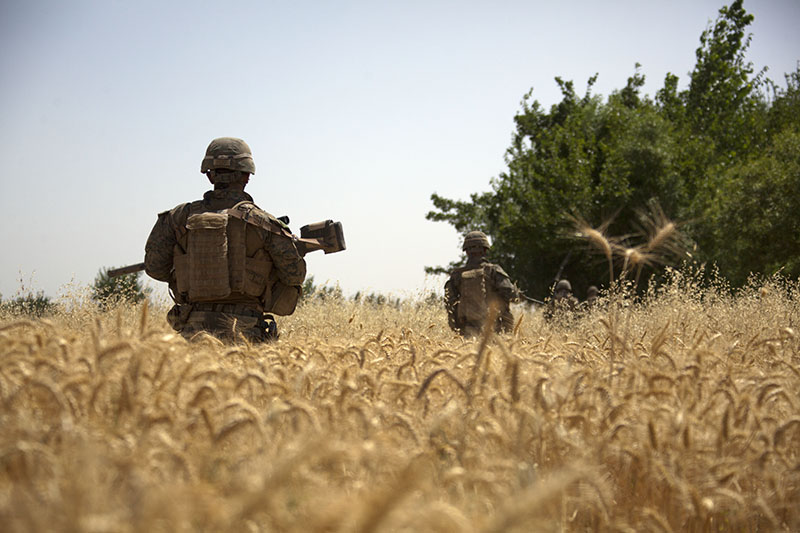
As a secondary MOS code (either 8541 or 0317), the structure, administration and implementation of the scout sniper program has changed over its history. Officers have never existed within the MOS, thereby limiting the weight of the community’s voice. The scout sniper MOS was disbanded in 2023, in accordance with Force Design. Currently, the 0322 reconnaissance sniper serves the Recon community in limited quantities with their long-range fires, and within each infantry battalion intelligence-gathering, sniping capabilities and specialized weapons are spread among the scout platoon and squad-level designated marksmen. The elimination of their MOS marked the foreseeable bookend of scout snipers’ 105-year history within the Corps.
In response to this abrupt conclusion, the SSA embarked on a mission to memorialize the MOS’s contributions to USMC history, physically embodied and represented through a statue erected outside the National Museum of the Marine Corps. To accomplish this task, a monumental feat of fundraising and design work on its own, the SSA incorporated the Marine Scout Sniper Heritage Foundation, linked legally to the association but operating as a separate entity.
The foundation has been in operation since March of 2024. MSgt Tim Parkhurst, USMC (Ret) serves as the founding president. Previously, Parkhurst served on the board of directors and as the president of the SSA for four years before stepping down to lead the new foundation. He served on active duty for 25 years, several of which were spent as a young scout sniper noncommissioned officer, before retiring in 2014.
“We decided we wanted our memorial to be a classical, figurative, bronze sculpture of a two-man sniper team, a shooter and an observer,” Parkhurst said. “As Marines, all of us are familiar with the cake cutting ceremony at the Birthday Ball. The oldest Marine present takes a bite, then passes it to the youngest Marine present and he takes a bite, symbolizing the passing of knowledge and experience from one generation to the next. We wanted to somehow portray that visually through our sculpture, so we decided to make the observer a sniper from a previous era and the shooter from Afghanistan, our latest era. All scout snipers are proud of being Marines first, and we have provided one of the many legacies of valor that many communities have provided over the years that has helped earn the laurels of the Marine Corps.”
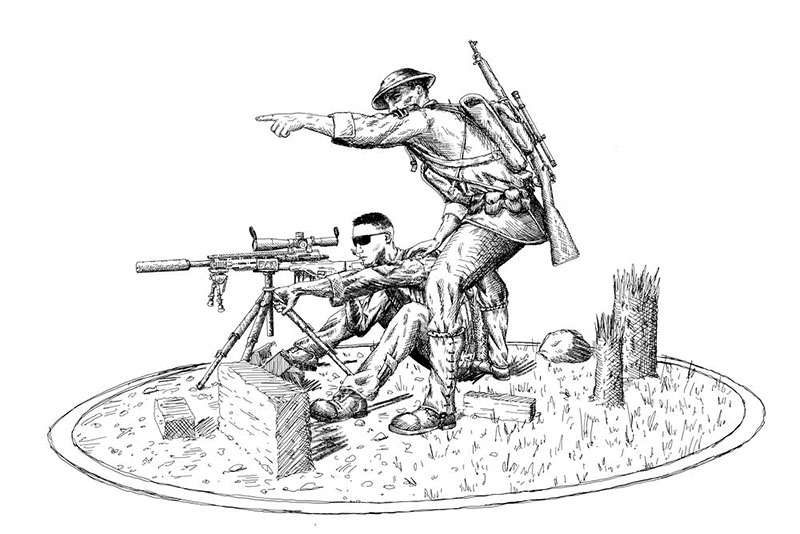
The foundation’s team initiated the fundraising enterprise associated with such an endeavor. Simultaneously, they dove headlong into the equally daunting task of research. For the memorial to appropriately honor the community’s war dead and the contribution of scout snipers to Marine Corps history, Parkhurst blieves the foundation should be able to put names with the Marines they are memorializing. The complex history of scout snipers makes this task exceedingly difficult.
“Most communities within the military serve in a primary MOS and have a home unit with muster rolls and things like that,” Parkhurst said. “But if you’re a scout sniper, you’re part of a larger infantry battalion, and throughout our history there was not always any official way to track who those Marines were.”
Additionally, insights into the origins of the MOS and other revelations about their beloved history were revealed as research proceeded.
“None of us anticipated the new things we were going to find,” Parkhurst continued. “Most grunts don’t know Marine Corps history. We like to think we know it because we went to boot camp. We started researching and decided to learn how far back the MOS went. We found things we never knew about, like a formal scout sniper program in Quantico dating back to 1918. That was the first time anyone in the American military called them scout snipers and we have ever since. All of the sudden our mission just got a whole lot broader trying to figure out all this history.”
Today, the foundation pursues four mission sets. The first and primary goal is to build the memorial along the Semper Fidelis Memorial Park outside the Marine Corps Museum. Second is to identify the names of fallen scout snipers across the history of the MOS to include in the memorial. Third is to continue uncovering the lost history of the MOS and eventually write comprehensive volume, along with a corresponding online database of reference material.
Lastly, the foundation hopes to educate Americans and Marines on the contributions scout snipers have made to our national defense across their 105 years of existence.
In light of the history already uncovered, the foundation is planning the memorial to encompass the entirety of their history. The observer, standing behind the shooter and calling out a target, represents a scout sniper from WW I, identified by his vintage uniform and iconic M1903 A5 Winchester sniper rifle slung across his back. The shooter, seated behind his weapon on its tripod, is modeled after the last generation of scout snipers to witness combat at Hamid Karzai International Airport in August 2021.
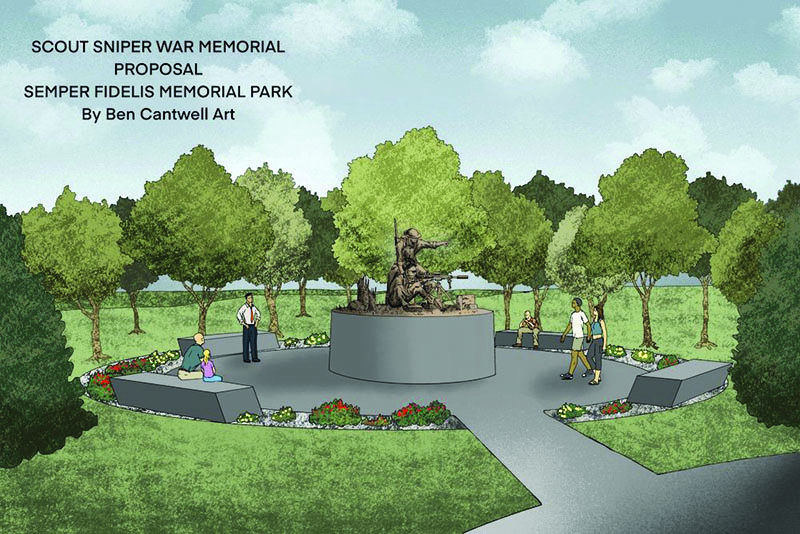
Concept drawings portray a finely detailed, engaging sculpture standing 11 feet tall. To produce such a magnificent work of art, the foundation has partnered with master sculptor Sabin Howard. Howard’s phenomenal work most recently achieved national prominence in September 2024 when his sculpture called “A Soldier’s Journey” was dedicated in Washington, D.C., as the National World War I Memorial. This 25-ton colossus of bronze is far more than just a statue. In fact, it contains 38 separate men and women, sculpted together across a 60-foot base, capturing the triumph and sacrifice of those who endured that conflict.
Now, the community of scout snipers plans to bring Howard’s extraordinary vision and passion to bear in memorializing their history. Once completed, the statue will be a stunning and attractive addition to the pathway outside the National Museum of the Marine Corps. The memorial will be situated just outside Marine Corps Base Quantico, where the first scout snipers were created in 1918, and will stand as the only memorial to this small, disbanded group of grunts in the nation.
Many challenges lay ahead to complete such an ambitious, world-class project. Its funding proves the most immediate hurdle.
“In our first nine months of operation, we organically raised around $150,000,” Parkhurst said. “That sounds like a lot of money, but when you need to raise $3 million, it’s not. We know we really need to ramp things up. If we’re only able to raise $150,000 per year, I’m going to be a really, really, old man by the time this thing is complete. It’s going to take a lot of people to get involved and help. To get the word out and have people advocate for this project is going to take a real marketing effort to reach an audience that we don’t currently reach.”
Equally important to the Marines tasked with the monument’s creation is the challenge of discovering the names of every scout sniper killed in action. The foundation’s website hosts an “In Memoriam” page listing 147 Marine scout sniper KIAs currently known. 59 of these come from the Global War on Terror between March 2003 and March 2020. As more research is conducted, more names from earlier generations will inevitably be added to the list.
“A lot of Marines talk about standing on the shoulders of giants,” Parkhurst reflected. “As scout snipers, over the last few decades we’ve always talked about guys like Chuck Mawhinney and Carlos Hathcock and guys like that from Vietnam. They are the shoulders on whom we stand. But what we know now is that we’ve got a ton more giants to stand on. We didn’t know that we have this incredible legacy, but now we do, and we’re finding more and more every day. We have hundreds of killed in action. It’s heartbreaking that we’ve paid such a high price from such a tiny community. If we are going to build a memorial to honor our war dead, it stands to reason that we would want to know their names. We feel like we are honor-bound to identify our fallen and we are going to exhaust every effort to do so.”
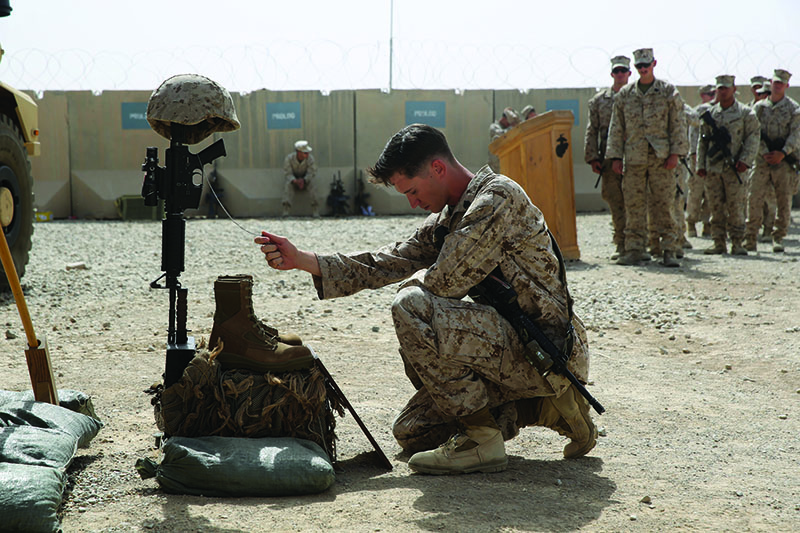
For those of us outside the community, the monument will serve as an immediate and telling representation of the immense pride held by scout snipers. For Marines who belong, the memorial will be a physical, lasting representation of the courage and sacrifice their members have displayed throughout their existence. Marine scout snipers served their units, their Corps and their country for more than 100 years, leaving a lasting impact. This memorial will indefinitely serve as a fitting and lasting tribute.
To help the community of scout snipers and their families, and to learn more about the USMC Scout Sniper Association, visit their website at https://scout
sniper.org/. To learn more about the Marine Corps Scout Sniper Heritage Foundation and contribute to their memorial, visit https://scoutsniperheritage.org/.
Author’s bio: Kyle Watts is the staff writer for Leatherneck. He served on active duty in the Marine Corps as a communications officer from 2009-13. He is the 2019 winner of the Colonel Robert Debs Heinl Jr. Award for Marine Corps History. He lives in Richmond, Va., with his wife and three children.




